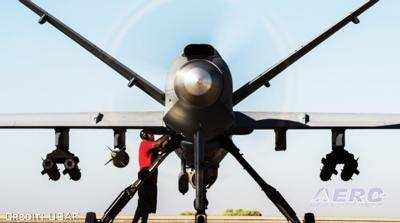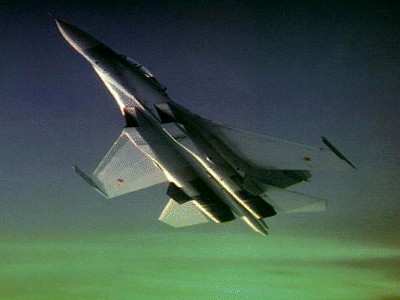Skepticism Expressed
U.S. officials have released video that shows a Russian Su-27 fighter jet colliding with the aft-mounted pusher-propeller of a U.S. MQ-9 Reaper Unmanned Aerial Vehicle (UAV).

The newly declassified video, which U.S. European Command released early Thursday, 16 March 2023, depicts—albeit less than transparently—the critical moments leading up to and immediately following the 14 March midair collision that allegedly resulted in the downing of the $20-million USAF drone.
The video was reportedly recorded by an aft-facing camera aboard the MQ-9 and encapsulates a field-of-view that includes a facet of the UAV’s empennage and the lower 180° of its propeller-arc. Two passes of a Russian Su-27 Flanker fighter jet are depicted. The first culminates with a pixelated screen U.S. officials ascribe to jet-fuel being dumped on the MQ-9 by the passing Su-27. The video-feed, restored some seconds later, captures what appears to be the UAV’s propeller turning normally. The second Su-27 pass culminates with another pixelated screen, but resolves to a view of the MQ-9’s propeller turning listlessly and one of its four blades sporting a badly-bent tip.
According to Pentagon accounts, the U.S. military was compelled by circumstance to purposefully crash the damaged UAV into the Black Sea—but not before technicians were able to wipe the drone of sensitive data—lest it fall into Russian or Chinese hands.
Speaking at a 15 March briefing, Chairman of the Joint Chiefs of Staff, General Mark Milley stated: "It [the MQ-9] probably broke up, probably not a lot to recover, frankly. … As far as the loss of anything of sensitive intelligence, etc., as normal we would take, and we did take, mitigating measures. So we are quite confident that whatever was of value is no longer of value."
That part of the Black Sea into which the MQ-9 plunged is four-to-five-thousand-feet deep. Nevertheless, the odds that the UAV’s wreckage will be found favor Moscow insomuch as Russian ships are currently on station at the Reaper’s crash-site while the U.S. Navy, conversely, hasn’t a single ship in the Black Sea.
To the subject of the Russian maritime response, U.S. officials remarked: "They wasted no time.”

Two U.S. military fighter pilots disputed the notion that the Su-27s dumped fuel on the drone, contending convincingly that any fuel the Russian pilots may have intended to release from their respective aircraft would have vaporized instantly upon coming in contact with the atmosphere, therefore having no more effect on the MQ-9 than a cirrus cloud.
Ukraine, meanwhile, maintains the alleged incident is a Russian attempt to escalate U.S. involvement in the Russo-Ukraine conflict. Ukrainian officials, however, offered no reason why Moscow would seek to directly engage the U.S. in a shooting war.
Ukrainian National Security and Defense Council Secretary Oleksiy Danilov stated: "The incident with the American MQ-9 Reaper UAV—provoked by Russia over the Black Sea—is Putin's way of signaling his readiness to expand the conflict to involve other parties. … The purpose of this all-in tactic is to always be raising the stakes."

On Wednesday, 15 March, U.S. Secretary of Defense Lloyd Austin and General Milley undertook conversations with their Russian counterparts; neither officials’ office provided details pertaining to the content of subject discussions. What’s more, Russian Ambassador Anatoly Antonov—who repudiated the U.S. account of the Black Sea incident—was summoned to Washington D.C.
"We assume that the United States will refrain from further speculation in the media and stop flights near Russian borders," Antonov asserted.
U.S. Ambassador to Russia Lynne Tracy conveyed a similarly terse message to the Russian Ministry of Foreign Affairs.
The U.S. MQ-9 went down in waters near Zmiinyi Island—a Ukrainian holding located in the northwestern Black Sea near the Danube Delta. The island plays an important role in the delineation of Ukrainian’s territorial waters.
Developed in the early 2000s by General Atomics Aeronautical Systems primarily for the United States Air Force, the MQ-9 is a dated platform. Specimens of the Unmanned Aerial Vehicle (UAV) have been lost over Afghanistan, Syria, and other countries predisposed to enmity with the U.S. and their wreckage likely recovered by enemy combatants. What, if any, military intelligence the downed MQ-9 drone might yield to Moscow remains unclear.

General James B. Hecker, commander of U.S. Air Forces Europe-Air Forces Africa, set forth in a 14 March statement: “Our MQ-9 aircraft was conducting routine operations in international airspace when it was intercepted and hit by a Russian aircraft, resulting in a crash and complete loss of the MQ-9. … In fact, this unsafe and unprofessional act by the Russians nearly caused both aircraft to crash.”
Whether or not the Su-27 was damaged in the incident remains unknown.
EUCOM added in a separate statement that the collision “demonstrates a lack of competence” on behalf of the Russians.
In February 2022, Russian Su-35 fighter jets crossed the flightpath of a U.S. Navy P-8 surveillance aircraft over the Mediterranean Sea, nearing to within five-feet of the 737-derivative ISR aircraft. Alluding to the antecedent instance in the wake of the MQ-9’s downing, EUCOM stated: “This incident follows a pattern of dangerous actions by Russian pilots while interacting with U.S. and Allied aircraft over international airspace, including over the Black Sea.”
 ANN's Daily Aero-Term (04.24.24): Runway Lead-in Light System
ANN's Daily Aero-Term (04.24.24): Runway Lead-in Light System ANN's Daily Aero-Linx (04.24.24)
ANN's Daily Aero-Linx (04.24.24) Aero-FAQ: Dave Juwel's Aviation Marketing Stories -- ITBOA BNITBOB
Aero-FAQ: Dave Juwel's Aviation Marketing Stories -- ITBOA BNITBOB Classic Aero-TV: Best Seat in The House -- 'Inside' The AeroShell Aerobatic Team
Classic Aero-TV: Best Seat in The House -- 'Inside' The AeroShell Aerobatic Team Airborne Affordable Flyers 04.18.24: CarbonCub UL, Fisher, Affordable Flyer Expo
Airborne Affordable Flyers 04.18.24: CarbonCub UL, Fisher, Affordable Flyer Expo






